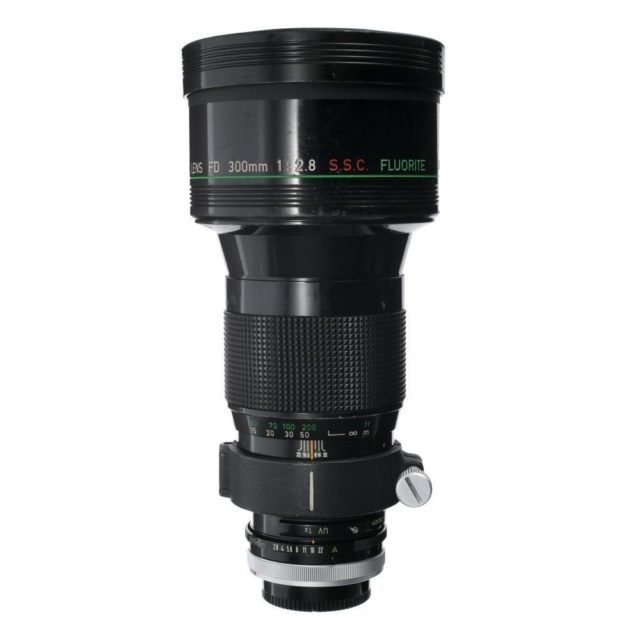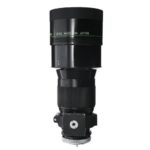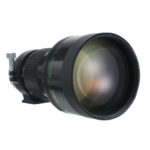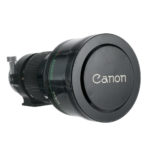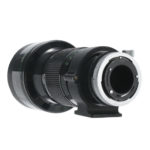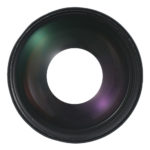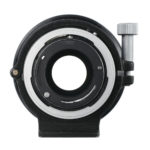Announced
Production status
Original name
System
Pros and cons
Genres or subjects of photography
Recommended slowest shutter speed when shooting static subjects handheld
Canon FD 300mm F/2.8 S.S.C. Fluorite
Super telephoto prime lens • Film era • Discontinued
Abbreviations
| FD | The lens is designed for Canon 35mm film SLR cameras with the Canon FD mount. |
| S.S.C. | Multi-layer Super Spectra coating is applied to the surfaces of lens elements. This anti-reflection coating increases light transmission, eliminates flare and ghosting, and maintains color consistence among all lens models. |
Model history
| ■Canon FL 300mm F/2.8 S.S.C. Fluorite | M | 6 - 5 | 3.50m | -- | 1974 ● | |
| ■Canon FD 300mm F/2.8 S.S.C. Fluorite | A | 6 - 5 | 3.50m | -- | 1975 ● | |
| ■Canon FDn 300mm F/2.8L | A | 9 - 7 | 3.00m | -- | 1981 ● | |
Specification


| Optical design: | |
| 300mm | |
| F/2.8 | |
| 35mm full frame | |
| Canon FD [42mm] | |
| 8.2° (35mm full frame) | |
| 6 elements in 5 groups | |
| 1 FL | |
| Diaphragm mechanism: | |
Diaphragm type: | Automatic |
Aperture control: | Aperture ring (Manual settings + Auto Exposure setting) |
| 9 (nine) | |
| Focusing: | |
| 3.5m | |
| 1:10 | |
Focusing modes: | Manual focus only |
Manual focus control: | Focusing ring |
| Physical characteristics: | |
| 1900g | |
| ⌀112×230mm | |
| Accessories: | |
| Removable front filters are not accepted | |
Additional features: | Drop-in filter holder (34mm) |
| Built-in telescopic round | |
| Canon Extender FD 1.4X-A → 420mm F/3.9 | |
| Canon Extender FD 2X → 600mm F/5.6 | |
| Canon Extender FD 2X-A → 600mm F/5.6 |
Sources of data
- Canon FD instructions (PUB. II01-012A) (October 1978).
- Canon FD interchangeable lenses booklet (PUB. IE01-075) (May 1979).
- Canon FD interchangeable lenses booklet (PUB. C-IE-075AF) (May 1981).
- Canon interchangeable lenses sales guide.
- Canon AE-1 booklet (PUB. CE1057) (June 1976).
- Canon EF instructions (PUB. IE 1008P) (May 1976).
- Canon F-1 booklet (PUB. CE1017F) (December 1975).
- Canon A-1 booklet (PUB. C-CE-0990) (September 1980).
- Canon AE-1 booklet (PUB. C-CE-1056AB) (September 1980).
- Canon AT-1 booklet (PUB. CE1065) (November 1976).
- Canon FD lenses inctructions (PUB. A5368z) (January 1978).
- Canon interchangeable lenses FD booklet (PUB. C-IE-075AQ) (March 1982).
- Canon FD lenses instructions (PUB. II01-061I) (July 1979).
- Canon FD interchangeable lenses booklet (PUB. C-IE-075AL) (December 1981).
- Canon FD Lenses in a Nutshell booklet (PUB. IE-1033Q) (April 1979).
- Canon AE-1 - A new generation booklet (PUB. CE1056A) (July 1976).
- Canon AE-1 booklet (PUB. C-CE-1056Y) (February 1980).
- Canon Products Guide (PUB. E5077t) (April 1978).
- Canon Products Guide (PUB. D5077k) (November 1975).
- Canon Products Guide (PUB. CE01-114B) (July 1979).
- Canon AT-1 booklet (PUB. CE1074H) (December 1977).
- Canon Products Guide (PUB. D5077n) (February 1976).
- Canon Products Guide (PUB. D5077s) (August 1976).
Manufacturer description #1
This lens is an artificial fluorite lens which has just been developed, especially for those cameramen engaged in news and indoor sports photography. This lens is an improved version of the Canon Lens FL-F 300mm f/2.8 S.S.C. and has been designed as a FD lens for better operation which results from the reduced diameter of the focusing ring so that through-the-lens (TTL) metering is performed with the lens at maximum aperture like the general FD lenses. As an accessory, the exclusive Canon Extender FD 2x was made at the same time. The combined use of the Extender FD 2x allows the FD300mm f/2.8 to serve as a 600mm f/5.6 lens with high quality results.
With the addition of an artificial fluorite crystal to this lens, its telephoto ratio was considerably reduced while maintaining its performance. It has successfully been made in a compact size with a large aperture of f/2.8. Because of its high performance which is attributable to the fluorite, this lens could work as a super telephoto lens with a 600mm focal length, if the Extender FD 2x were used with it. Chromatic aberration is completely eliminated by the fluorite. Moreover, this lens compensates for curvature of the field and coma by improving the optical system by adopting new glass and balancing the design. It really provides high contrast and resolving power in every corner of the film. Other characteristics can be found in this lens, such as coatings bringing color reproduction to life and thoroughly eliminating ghost and flare, and a ball bearing system enabling smooth focusing.
The extender FD 2x has been designed exclusively for the FD300mm f/2.8 S.S.C. FLUORITE, and cannot be used with other lenses.
Filter Setting
There are five kinds of filters: REGULAR 1x, UV 1x, R1 6x, Y3 2x and ND 4x. The filter is fixed on the holder and it can be unlocked by pressing a pin type lock on the filter's top. Simply insert the filter holder into the filter slot in the rear part of the lens barrel to automatically lock it. When removing the filter holder from the lens barrel, press down the lock pin with your forefinger and pull out the holder using your thumb and middle finger gripping both ends of the holder.
Since this lens is designed to include the filter, it always has to be used with the filter. Without the filter, the light coming in may affect the picture's image. Therefore, even when a filter effect is not necessary, the filter, REGULAR 1x should be inserted.
Manufacturer description #2
Canon designers outdid themselves with this lens. When this lens' FL predecessor was first introduced in 1969, it was the first lens in the world to have a fluorite element. That was the year that Canon was the first lens maker to succeed in mass-producing artificial calcium fluoride crystals large enough to consitute a lens element; natural fluorite is too small. The advantage of the fluorite element is that it corrects chromatic aberration and the secondary spectrum, which become worse and more difficult to correct with longer focal lengths, to a degree which is simply impossible with normal optical glass. As a result, this superior apochromatic lens produces images with unparalleled resolution and color balance. The fluorite element and its exceptional speed make this the Cadillac of lenses for the uncompromising photographer.
Manufacturer description #3
This is a lens aimed at improving the performance of the FL300mm f/2.8 S.S.C. large-aperture telephoto lens, which was released in February 1974, using fluorite that is popular among demanding professional users including press photographers, while also offering full-aperture metering and automatic diaphragm control.
Together with this lens the FD 2x Extender was also developed, and when used with the extender the FD300mm f/2.8 S.S.C. Fluorite Lens can also fully exhibit the functions and performance of a FD600mm f/5.6 S.S.C. Fluorite Lens.
Despite being a large aperture telephoto lens with a brightness of f/2.8, the combination of a fluorite lens element and optical glass elements keeps chromatic aberration extremely small, offering high-resolution and high-contrast definition even at maximum aperture, while also achieving light and smooth focusing through the adoption of a new bearing method for the helicoid.
Furthermore, automatic diaphragm control of a large aperture telephoto lens, which was previously considered to be difficult due to the time lag from the diaphragm blades, has been achieved through the development of a new diaphragm unit, improving operability as a new type of zoom lens.
Other super telephoto prime lenses in the Canon FD system
Sorted by focal length and speed, in ascending order
| ■Canon FD mount (19) | |||||||||
| Canon FD 300mm F/5.6 | A | 6 - 5 | 4.00m | ⌀58 | 1971 ● | ||||
| Canon FD 300mm F/5.6 S.C. | A | 6 - 5 | 4.00m | ⌀58 | 1973 ● | ||||
| Canon FD 300mm F/5.6 S.S.C. | A | 6 - 5 | 3.00m | ⌀55 | 1977 ● | ||||
| Canon FDn 300mm F/5.6 | A | 6 - 5 | 3.00m | ⌀58 | 1979 ● | ||||
| Canon FD 300mm F/4 S.S.C. | A | 6 - 6 | 3.00m | -- | 1978 ● | ||||
| Canon FD 300mm F/4L | A | 7 - 7 | 3.00m | -- | 1978 ● | ||||
| Canon FDn 300mm F/4 | A | 6 - 6 | 3.00m | -- | 1979 ● | ||||
| Canon FDn 300mm F/4L | A | 7 - 7 | 3.00m | -- | 1980 ● | ||||
| Canon FDn 300mm F/2.8L | A | 9 - 7 | 3.00m | -- | 1981 ● | ||||
| Canon FD 400mm F/4.5 S.S.C. | A | 6 - 5 | 4.00m | -- | 1975 ● | ||||
| Canon FDn 400mm F/4.5 | A | 6 - 5 | 4.00m | -- | 1981 ● | ||||
| Canon FDn 400mm F/2.8L | A | 11 - 9 | 4.00m | -- | 1981 ● | ||||
| Canon FD 500mm F/4.5L | A | 8 - 7 | 4.00m | -- | 1979 ● | ||||
| Canon FDn 500mm F/4.5L | A | 8 - 7 | 5.00m | -- | 1981 ● | ||||
| Canon FD 600mm F/4.5 S.S.C. | A | 6 - 5 | 8.00m | -- | 1976 ● | ||||
| Canon FDn 600mm F/4.5 | A | 6 - 5 | 8.00m | -- | 1981 ● | ||||
| Canon FD 800mm F/5.6 S.S.C. | A | 6 - 5 | 14.00m | -- | 1976 ● | ||||
| Canon FD 800mm F/5.6L | A | 7 - 6 | 14.00m | -- | 1979 ● | ||||
| Canon FDn 800mm F/5.6L | A | 7 - 6 | 14.00m | -- | 1981 ● | ||||
Lenses with similar focal length
Sorted by manufacturer name
| ■Canon FD mount (2) | |||||||||
| Sigma MF 300mm F/2.8 APO ZEN | A | 12 - 9 | 2.50m | -- | 1988 ● | ||||
| Tokina AT-X SD 300mm F/2.8 | A | 9 - 7 | 2.40m | ⌀112 | 1986 ● | ||||
| ■Interchangeable mount (3) | |||||||||
| Tamron SP 300mm F/2.8 LD 107B [Adaptall-2] | A | 7 - 6 | 3.00m | ⌀112 | 1983 ● | ||||
| Tamron SP 300mm F/2.8 LD [IF] 60B [Adaptall-2] | A | 10 - 7 | 2.50m | ⌀112 | 1984 ● | ||||
| Tamron SP 300mm F/2.8 LD [IF] 360B [Adaptall-2] | A | 10 - 7 | 2.50m | ⌀112 | 1993 ● | ||||
